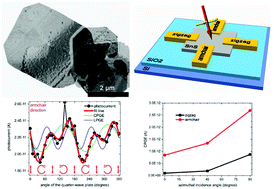Anisotropic circular photogalvanic effect in colloidal tin sulfide nanosheets†
Abstract
Tin sulfide promises very interesting properties such as a high optical absorption coefficient and a small band gap, while being less toxic compared to other metal chalcogenides. However, the limitations in growing atomically thin structures of tin sulfide hinder the experimental exploration of these properties. Due to the flexibility of the colloidal synthesis, it is possible to synthesize very thin and at the same time large nanosheets. Electrical transport measurements show that these nanosheets can function as field-effect transistors with an on/off ratio of more than 105 at low temperatures and p-type behavior. The temperature dependency of the charge transport reveals that defects in the crystal are responsible for the formation of holes as majority carriers. During illumination with circularly polarized light, these crystals generate a helicity dependent photocurrent at zero-volt bias, since their symmetry is broken by asymmetric interfaces (substrate and vacuum). Further, the observed circular photogalvanic effect shows a pronounced in-plane anisotropy, with a higher photocurrent along the armchair direction, originating from the higher absorption coefficient in this direction. Our new insights show the potential of tin sulfide for new functionalities in electronics and optoelectronics, for instance as polarization sensors.



 Please wait while we load your content...
Please wait while we load your content...